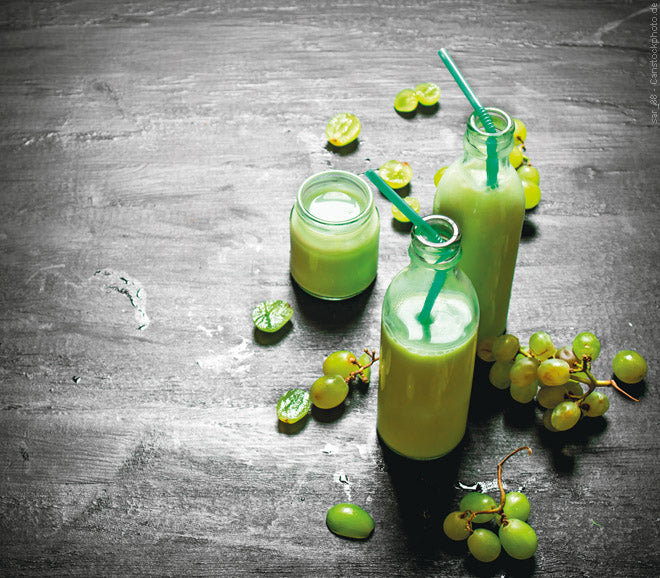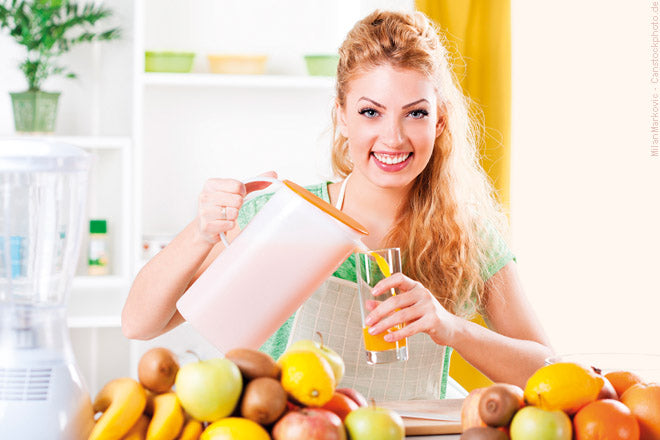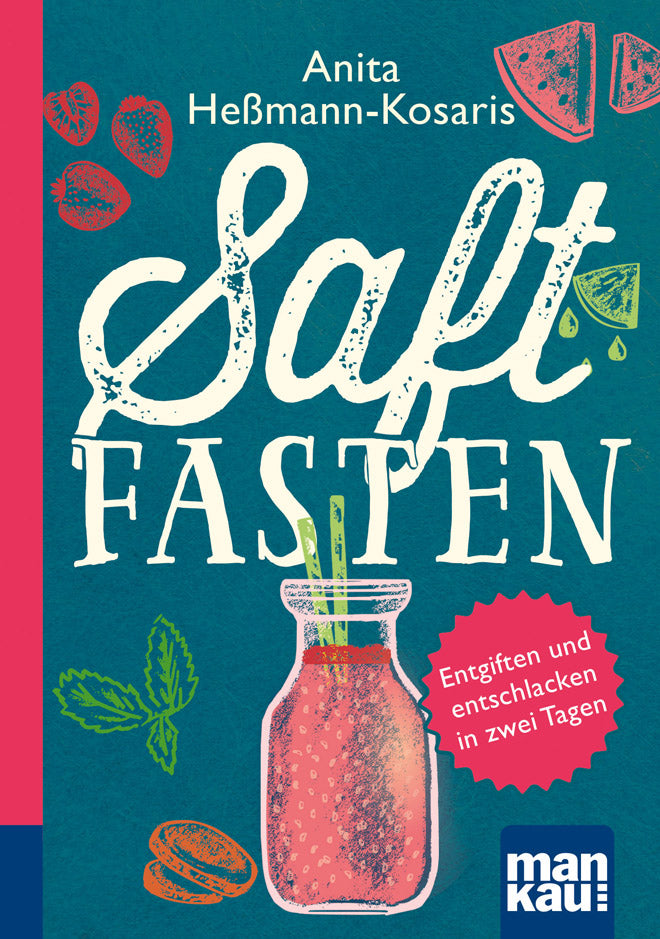
Interview with Anita Heßmann-Kosaris: Juice fasting on the weekend – the quick cure for your health and your figure
Interview with Anita Heßmann-Kosaris: Juice fasting on the weekend – the quick cure for your health and your figure
"Juice fasting is a wonderful and tasty opportunity to detoxify your body, strengthen your immune system and get your figure in shape! The fasting juices with their plant substances - to which oat flakes, nuts or yoghurt can also be added if desired - are sufficiently filling so that no one has to worry about a nagging feeling of hunger. Together with a few simple 'wellness measures', a fasting weekend quickly becomes a beloved and extremely healthy habit!" The alternative practitioner Anita Heßmann-Kosaris , author of the compact guide "Juice fasting" , provides numerous delicious recipes for fasting juices and recommendations for additional measures - for completely successful feel-good weekends in any season.
With juice fasting, it is possible to detoxify and purify the body in just two days - perhaps a weekend. Who is this "quick fix" best suited for?
Heßmann-Kosaris: It is ideal for anyone whose daily work life leaves too little time to plan a longer break. Or for those who cannot cope with the metabolic changes that come with a longer fasting regime. Anyone who is healthy and fit, i.e. not seriously ill, can fast for a short period of time. These juice fasting days can be done several times a year at intervals of two or three months. Anyone who suffers from rheumatism, gout, diabetes, gastrointestinal problems or other metabolic diseases should first clarify with their doctor whether and how juice fasting is an option.
What is the difference between classic fasting and juice fasting?
Heßmann-Kosaris: When you're fasting on juice, you don't have to worry about feeling hungry like you can with classic fasting diets. The plant substances in the juices mean you consume a few calories. This is especially true if you opt for the milder detoxification option, where small additions like yogurt, nuts or oatmeal are allowed. The trimmings are also pleasant: you can sleep in, laze around, read, go for a walk, do sports and much more.
Why are fruits and vegetables in liquid form so valuable?
Heßmann-Kosaris: The ingredients in these juices naturally stimulate the body to rid itself of toxins and harmful waste. The liquid food contains a unique composition of highly effective plant substances such as vitamins, minerals and trace elements in such a concentrated form that the body can use them very well. After just a few sips, the substances dissolved in the liquid pass from the stomach to the small intestine and from there are transported via the bloodstream to the cells and organs. With solid food, however, it can take hours for the cells to benefit from the nutrients. When fasting on juice, the body is also largely spared fats and proteins. This allows the organism to use energy that it would otherwise have to use to process daily food to detoxify and purify.
“Detoxing” or “purifying” is very popular at the moment and is recommended by many people, although there are also skeptics who doubt the existence of “toxins” in the body. What is this all about and what effects can be proven in the organism?
Heßmann-Kosaris: “Detoxification” here refers to the process by which the organism rids itself of the waste that has accumulated over time. Normally, the body can get rid of the residues through the detoxification organs in a kind of self-regulation. The elimination of toxic and unusable end products of digestion takes place with the help of water via the detoxification systems: the kidneys excrete the substances through urine, the lungs with water vapor through the air we breathe, the skin through sweat and the intestines through feces. However, the detoxification organs are overwhelmed when too much metabolic waste and toxins from outside have accumulated in the organism. These not only settle in the detoxification organs themselves, but also accumulate in the blood vessels, the connective and supporting tissues, the muscles, joints and organs. These “toxins” also include the omnipresent pollutants and environmental chemicals that are absorbed through the skin with food, drinking water and the air we breathe and that significantly damage the body’s own detoxification system.
The fact that all of these substances are referred to in popular science as "slag" causes many experts to shake their heads. The idea that - similar to a coal stove - certain residues accumulate in the body during digestion, i.e. the combustion process of food, is not correct in their opinion. After all, the body immediately excretes unusable metabolic waste products and toxins in a natural way. However, recent scientific findings show that this is not without consequences: when undigested food is broken down by bacteria in the body, a large number of substances are created (such as phenols, indoles, amines, polyamines, nitrosamines, formaldehyde, alcohols and fusel oils), some of which have toxic, mutagenic or carcinogenic properties. These sensitive substances can be detected throughout the body using sophisticated analytical methods. Although the toxic substances are "washed out" of the body, i.e. not deposited, similar to medication, they can cause considerable damage to cellular structures and biochemical functional systems.
The proponents of the detoxification theory prove that there can actually be harmful "deposits" with a simple example: gout. Here, uric acid crystals are deposited in the joints, ears, bursae, muscles and tendon sheaths and are not excreted as nature "normally" intended.
Whether the physical processes are a matter of "purification" or "detoxification", there is no doubt about it: inadequate "garbage disposal" will sooner or later affect a person's performance. The first sign of this can be, for example, unreasonable tiredness. Sooner or later, the entire organism will be affected if the body's own "sewage treatment plants" are overloaded. The consequences can be seen and felt: excess weight, impure skin, bloated tissue, flatulence, constipation, malaise. In addition, overtaxed detoxification systems pose a health risk, leading to the development of so-called diseases of civilization such as cardiovascular disorders, rheumatism, gout, diabetes and even cancer.
How does fasting with fruit and vegetable juices work?
Heßmann-Kosaris: The fasting principle is extremely simple. Throughout the day, you drink around three quarters of a litre of fruit and vegetable juice, which you squeeze yourself or buy. The lion's share of this should be fruit and vegetable juice. The tasty medicinal plant juices are only added as small "add-ons". You also drink lots of clear water. This is important so that there is enough liquid to flush the dissolved toxins out of the body.
Do any requirements have to be met or special precautions have to be taken?
Heßmann-Kosaris: The effort is manageable. You don't need a lot of equipment: a vegetable brush, a sharp knife, a cutting board, kitchen scales and a glass measuring cup. And of course the usual household juicers and a mixer or hand blender. The latter are ideal for making a puree from fruit, vegetables or herbs. This can easily be diluted with clear water to make a juice or turned into a delicious smoothie that can be enriched with other ingredients. A simple hand press is enough to get the liquid out of citrus fruits; for more demanding requirements you need an electric juicer, preferably with a press piston.
Can you also fast with ready-made juices?
Heßmann-Kosaris: Yes, absolutely, that is a particularly convenient solution. If you don't have the opportunity to prepare your own juice, you can use organic juices from the store to complete the two fasting days. These industrially produced products are a good choice if vegetables (such as artichokes or asparagus), fruits (such as elderberries or sea buckthorn berries) or herbs (such as nettles, birch leaves or dandelions) are not available fresh or can only be prepared with great effort. It is important that the ready-made juices have been preserved gently and without chemical additives. They should not contain any preservatives or colorings, should not be enriched with bioactive substances (calcium in orange juice, for example) and should not contain any additional sweeteners. Fruit juices already contain around eight to ten percent natural fructose. Enough to get through the detox days without being agonizingly hungry.
What should you pay attention to if you want to prepare the juices yourself?
Heßmann-Kosaris: With powerful blenders and power juicers, juice can be prepared in no time at all. However, a healthy (!) fasting drink can only be made from it if the best ingredients are used. When buying the "raw materials", you can already keep an eye on whether the goods are flawless. The market-fresh fruit, vegetables and herbs should be organically grown if possible, so that the body is not unnecessarily burdened with additional chemical substances during the fasting weekend. Organically grown plants are not completely free of harmful substances, but they contain fewer residues of artificial fertilizers and pesticides than products from conventional cultivation. The washed raw materials only need to be peeled if necessary. The procedure is intended to rid the plants of harmful residues. For untreated root and tuber vegetables such as carrots or celery, it is sufficient to brush them under running water. The fruits and vegetables to be processed should be ripe, but not overripe. The juice should be prepared quickly from freshly purchased or home-harvested produce and should ideally be consumed immediately so that the body can benefit from as many of the valuable organic substances as possible.
Are there fruits and vegetables that are not suitable for juice fasting?
Heßmann-Kosaris: Yes, there is. Vegetables that are not edible raw should be blanched before juicing. Potatoes, onions and eggplants are tricky. Raw potatoes have a laxative effect, onion juice quickly becomes bitter, and eggplants are simply inedible when raw. If you don't know the properties of certain plants, you should play it safe and use ready-made fresh plant juices that are available in stores, for example in health food stores or organic shops. Otherwise, all parts of plants that we could eat raw are suitable for juicing. Stone fruit such as apples or pears are juiced without seeds; cucumber, melon and pumpkin seeds, on the other hand, can be juiced together with the pulp. Herbs hardly need to be chopped; they can be put into the juicer with the stump and stem intact.
Which types of fruit and vegetables are recommended to specifically stimulate the production of digestive juices and the metabolism and to improve the excretion of waste products?
Heßmann-Kosaris: These are all types of fruit and vegetables that have a dehydrating effect due to their high potassium content, and those that have an extremely high alkaline content - and are also used by the body as alkaline. This allows the excess of harmful acids to be banished from the body. Beetroot juice, carrot or artichoke juice, for example, bring the acid-base balance back into balance. The effect can be increased even further if the juices are drunk warm, as is easily possible with pineapple, cherry, lemon or orange juice. In general, vegetable juices are almost more important than fruit juices for a detoxification cure as a source of bioactive, detoxifying plant substances; the body immediately absorbs a large proportion of the valuable bio-substances from vegetables in liquid form via the bloodstream. To get the same amount from raw vegetables, we would have to consume a lot more of them. Example: A glass of carrot juice contains as many nutrients as four glasses of raw, chopped carrots. A glass of tomato juice contains as many nutrients as six individual tomatoes. Another advantage of vegetable juices: They are easier on the stomach because they usually contain less acid than fruit juices.
What is the benefit of mixing juices?
Heßmann-Kosaris: The positive benefits of the juices can be increased by combining particularly suitable varieties. In the past, it was strictly advised not to mix fruit and vegetable juices because this can cause flatulence; however, practice has shown that juices made from green vegetables and spicy herbs in particular are more digestible when mixed with mild fruit juices.
In your compact guide you present weekend programs for all seasons. What is the difference between juice fasting in spring, summer, autumn and winter?
Heßmann-Kosaris: The freshly pressed ingredients vary depending on the season. In spring, for example, freshly harvested herbs, juicy fruits and young vegetables gently stimulate sluggish digestion and excretion. The summery variety is ideal for mixed drinks with sour milk products and their metabolism-boosting properties. In autumn, recipes with mild fruits and vegetables dominate, which are currently in season here - and which mobilize the body's defenses in addition to digestive and metabolic work. In winter, in addition to classic vegetables such as cabbage, carrots or turnips, rich drinks with a balanced ratio of potassium, sodium and bitter substances ensure fullness and variety. The wellness program is also adapted to the season depending on the temperature and weather.
And what happens after fasting?
Heßmann-Kosaris: After the fasting weekend, it makes sense to make small adjustments to your ingrained daily habits in order to stay on the road to success in terms of health and to maintain your weight. This includes not rushing, eating with enjoyment and calmly, eating a varied and balanced diet with a mixed diet, and preferring foods that are fresh and natural. Low-carbonated mineral water is ideal for quenching thirst, as are fruit and herbal teas and diluted organic juices. Regular exercise is also recommended: brisk walking, cycling, swimming - simply anything that makes it easier for the body to get rid of its old burdens more quickly and improves well-being.
Book tip:
Anita Heßmann-Kosaris: Juice fasting. Compact guide. Detox and purify in two days. Mankau Verlag, 1st edition January 2018. Paperback 11.5 x 165 cm, color, 126 pages, ISBN 978-3-86374-429-8, 8.99 euros (D) / 9.20 euros (A).
Link recommendations:
More information about the "Juice Fasting" guide
To the reading sample in PDF format
More about Anita Heßmann-Kosaris











